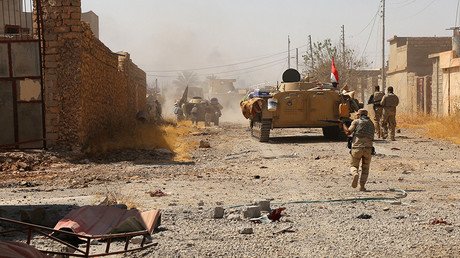Sappers’ nightmare: RT films devastation in heavily booby-trapped Tal Afar
Booby-traps and mines left behind by Islamic State in emptied houses, destruction and almost no civilians – this is the reality in a town of Tal Afar liberated with great fanfare by US-backed Iraqi forces. RT’s crew has filmed the gruesome remnants of war.
US-backed Iraqi troops entered the strategic town of Tal Afar earlier this week, but there is still long way to go until life returns to normal. RT correspondent Murad Gazdiev has seen the neighborhoods of the town literally paved with explosive devices.
“A day after the victory was announced in Tal Afar, fighting still hasn’t died down,” Gazdiev reported, standing in front of improvised graffiti that read in Arabic: “Islamic State [IS, formerly ISIS/ISIL] will remain.”
While forced to retreat from most of Tal Afar’s neighborhoods, the jihadists are still hiding in basements, buildings and underground tunnels in order to ambush Iraqi forces. Occasional skirmishes still take place between the Iraqis and Islamists, but the greatest dangers are hidden inside the buildings.
Islamic State militants have left plenty of “deadly surprises”, Gazdiev said, adding, “They have turned the city into a sappers’ nightmare.” RT crew have repeatedly been warned not to touch anything no matter how innocent it seems – a clear reminder that the peace there remains fragile.
“One of our officers went into a house and sat on a sofa. It exploded, along with half of the house,” an Iraqi commander explained. “They booby-trapped the sofa.”
“Another example: there were explosives in the light switches. If you turn the light on, it explodes. There were bombs in refrigerators and even in door handles.”
Another officer said the troops cannot even use the beds without checking them for explosives: “There are wires everywhere. We don’t dare touch anything.”
Leaving the town, the militants failed to evacuate some of their weaponry. A car packed with explosives was found in Tal Afar. The loud bang and plumes of thick smoke coming after a controlled detonation suggested that the deadly vehicle could have left many casualties amid fierce fighting.
The town, liberated with much triumphalism, still leaves an awkward impression on the visitor. Many houses have been reduced to rubble; the roads have been damaged. RT crew were not allowed to see the center of Tal Afar, but even in the suburbs there were no civilians in sight.
READ MORE: Iraq’s new ground zero: Thousands of civilians desperately fleeing Tal Afar battleground
Since the start of the offensive, more than 14,000 people have fled Tal Afar, while the total number of people who have escaped from the area since April is over 30,000, according to the Norwegian Refugee Council (NRC), a relief group there distributing aid.
The US-led coalition gives another estimate, saying that between 10,000 and 50,000 civilians remain in and around Tal Afar.
The fate of Mosul, another IS-stronghold captured by Iraqis, is no better. Recently, RT filmed multiple bodies, among them women and children, being steadily retrieved from under the rubble. Hundreds of corpses – decomposing in the heat – are presumed to be under collapsed buildings in the city that once was Iraq’s second-largest.
#Mosul: a city of corpses https://t.co/BA4dCTImRU
— Murad Gazdiev (@MuradGazdiev) August 24, 2017
More than $1 billion of financial aid and months of work will be needed to repair Mosul’s basic infrastructure alone, according to UN estimates.
An overhaul of water, sewage and electricity infrastructure, and reopening schools and hospitals, has twice exceeded initial cost estimates, the United Nations humanitarian coordinator for Iraq, Lise Grande, told Reuters back in July.
“In western Mosul what we're seeing is the worst damage of the entire conflict. In those neighborhoods where the fighting has been the fiercest, we're looking at levels of damage incomparable to anything else that has happened in Iraq so far,” she said.













